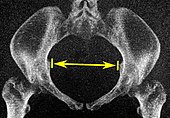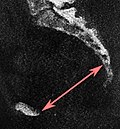Pelvimetry
Author:
Mikael Häggström [notes 1]
Planning
- Indication
A review in 2003 considered routine performance of pelvimetry to be a waste of time, a potential liability, and an unnecessary discomfort.[1] A woman's pelvis loosens up before birth by hormones, so an investigation before fetal passage does not represent the physiologic capacity of the birth canal. Still, pelvimetry can be indicated when a woman has had failure to progress in a previous pregnancy.
- Choice of modality
Low-dose 3D CT can be used for estimating pelvimetry parameters.[2]
Measurement
| Parameter | Image (maximum intensity projection)[2] |
End points | Normal measures | |
|---|---|---|---|---|
| Pelvic inlet | Transverse diameter of the pelvic inlet | 
|
Widest bony points of the iliopectineal lines | 13 to 14.5 cm.[2] |
| Obstetric conjugate |  Median plane |
The narrowest bony points formed by the sacral promontory and pubic bone by the symphysis. | 10 to 12 cm.[2] | |
| Pelvic outlet | Interspinous distance | 
|
The narrowest bone points of the ischial spines | 9.5 to 11.5 cm.[3] |
| Sagittal pelvic outlet diameter | 
|
The narrowest bony points formed by the middle of the coccyx[4] | 9.5 to 11.5 cm.[3] and the pubic bone by the symphysis. | |
| Intertuberous diameter | 
|
The ischial tuberosities | 10 to 12 cm.[3] | |
Interpretation
This only needs to be done if requested by the clinician, otherwise it is only necessary to state the numerical values of the parameters, in order to avoid implying any actual physiologic capacity of the pelvis.
| Normal | Borderline | Narrow | |
|---|---|---|---|
| Sum of inlet measures | >24 cm | 23- 24 cm | < 23 cm |
| Sum of outlet measures | >31,5 cm | 29,5 – 31,5 cm | <29,5 cm |
| Obstetric conjugate | >11,0 | 9,5 – 11,0 | <9,5 |
A sagittal outlet is < 8 cm or interspinous diameter is <7 cm is regarded as narrow, even if the sum of outlet measures is normal.[5]
Report
The length of each of the distances above, but make an interpretation of any narrowing only if requested.
If the images are taken during a pregnancy, note the position of the fetus.
Notes
- ↑ For a full list of contributors, see article history. Creators of images are attributed at the image description pages, seen by clicking on the images. See Radlines:Authorship for details.
References
- ↑ "A retrospective review of performance and utility of routine clinical pelvimetry ". Family Medicine 36 (7): 505–7. 2004. PMID 15243832.
- ↑ 2.0 2.1 2.2 2.3 "Pelvimetry by Three-Dimensional Computed Tomography in Non-Pregnant Multiparous Women Who Delivered Vaginally ". Polish Journal of Radiology 81: 219–27. 2016. doi:. PMID 27231494.
- ↑ 3.0 3.1 3.2 "Magnetic resonance pelvimetry for trial of labour after a previous caesarean section ". Sultan Qaboos University Medical Journal 10 (2): 210–4. August 2010. PMID 21509231.
- ↑ Sara Paterson-Brown, Phillip Bennett, Catherine Williamson (2010). Basic Science in Obstetrics and Gynaecology (Fourth Edition) - Obstetric pelvic definitions and dimensions . Elsevier Ltd. ISBN 978-0-443-10281-3.
- ↑ 5.0 5.1 Kira Kersting (2017-01-04). Kronoberg County Council.